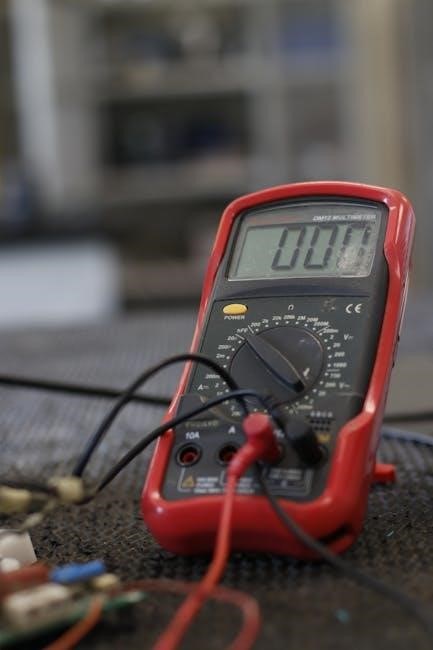The Polaroid Snap Camera is an innovative instant print digital camera that combines classic instant photography with modern digital features. It allows users to capture and print high-quality photos instantly, making it a popular choice for its ease of use and versatility.
Overview of the Polaroid Snap Camera
The Polaroid Snap Camera is a compact, user-friendly instant print digital camera designed for capturing and printing high-quality photos instantly. It features a 10-megapixel sensor, ensuring vibrant and detailed images. The camera supports various modes, including photo, video, and self-timer, making it versatile for different shooting scenarios. With its built-in printer, it uses ZINK Zero Ink Paper to produce smudge-proof, water-resistant photos. The Snap Camera is lightweight, portable, and easy to operate, making it ideal for casual photographers and instant photo enthusiasts. Its sleek design and intuitive controls provide a seamless photography experience, blending retro charm with modern technology.
Key Features of the Polaroid Snap Camera
The Polaroid Snap Camera boasts a range of impressive features, including a 10-megapixel CMOS sensor for crisp, high-quality images and a 3.5-inch LCD touchscreen for easy navigation. It supports Full HD 1080p video recording, allowing users to capture memories in motion. The camera includes a 10-second self-timer, perfect for group shots, and offers various photo effects to enhance creativity. With its built-in ZINK Zero Ink printer, it produces 2×3 inch photos instantly. The Snap Camera also features a micro USB port for easy charging and file transfers. Additionally, it supports up to 32GB of expandable storage, ensuring ample space for photos and videos. These features make it a versatile and convenient choice for photographers of all levels.

Getting Started with Your Polaroid Snap Camera
Unbox your Polaroid Snap Camera, charge the battery, and familiarize yourself with its controls. Insert the ZINK paper, power it on, and start capturing moments instantly.
Unboxing and Initial Setup
When you unbox your Polaroid Snap Camera, you’ll find the camera, a wrist strap, a micro USB cable, a quick start guide, and a warranty card. Ensure all accessories are included. Before first use, charge the battery using the micro USB cable until the indicator light turns green. Next, insert the ZINK Zero Ink Paper into the paper tray, ensuring it clicks into place. Power on the camera by pressing the power button on the viewfinder. The camera will automatically calibrate and prepare for use. If it doesn’t turn on, check the battery level or retry the power button. Your camera is now ready to capture and print photos instantly.
Charging the Battery
To charge your Polaroid Snap Camera, use the included micro USB cable. Connect one end to the camera’s micro USB port and the other to a compatible power source, such as a wall adapter or computer. The charging indicator light will turn red. Charging typically takes 2-3 hours, and the light will turn green when fully charged. Avoid overcharging, as this may affect battery life. If the camera feels warm during charging, this is normal. Ensure the camera is turned off during charging for optimal performance. For best results, use the original cable and avoid charging in extreme temperatures to maintain battery health.
Turning the Camera On and Off
To turn on your Polaroid Snap Camera, press the power button located on the top of the camera. The viewfinder will pop up, and the camera will be ready for use. If the camera is inactive for a few minutes, it will automatically enter sleep mode to conserve battery. To wake it up, press the power button or close and reopen the viewfinder. To turn the camera off completely, hold the power button until the LED light turns off. Always use the power button to turn off the camera to avoid draining the battery unnecessarily. This ensures optimal performance and extends battery life.
Understanding the Camera’s Controls and Interface
The Polaroid Snap Camera features an intuitive design with a user-friendly interface, including a LCD screen, navigation buttons, and a viewfinder for easy operation and menu access.
Navigation Buttons and Their Functions
The Polaroid Snap Camera features a set of intuitive navigation buttons designed to simplify operation. The power button, located on the viewfinder, turns the camera on and off. The timer button, found on the top, activates the 10-second self-timer for hands-free photography. The mode button allows users to switch between different shooting modes, while the directional buttons enable easy menu navigation and photo framing selections. These buttons provide quick access to key functions, making it easy to customize settings and capture memories instantly. Their straightforward layout ensures a seamless user experience, allowing photographers to focus on creativity without complexity.
Using the Viewfinder
The viewfinder on the Polaroid Snap Camera is essential for framing your shots accurately. To use it, simply look through the viewfinder and align your subject with the guides inside. The viewfinder also houses the power button, which you press to turn the camera on or off. When the camera is in use, the viewfinder remains open, providing a clear view of your scene. If the camera enters sleep mode, closing and reopening the viewfinder will reactivate it. For models with an LCD screen, the viewfinder complements the screen by offering an alternative way to frame photos. This dual functionality enhances your photography experience, ensuring you never miss a moment.
Accessing the Menu Options
To access the menu options on the Polaroid Snap Camera, press the menu button located on the top of the camera. Use the navigation buttons to scroll through the available options, such as print settings, timer, and photo effects. Select an option by pressing the shutter button. The menu allows you to customize settings like photo frames, brightness, and contrast. To exit the menu, press the return arrow button or wait for the camera to automatically exit after a few seconds of inactivity. This feature ensures you can easily adjust settings while maintaining a seamless user experience. Refer to the user manual for detailed guidance on advanced menu options.

Capturing Photos with the Polaroid Snap Camera
The Polaroid Snap Camera offers a 10MP sensor and 50.8 x 76.2 mm print size, delivering vibrant, instant photos. Use timers, frames, and effects for customizable captures, blending classic charm with modern convenience.
Basic Photography Mode
The Polaroid Snap Camera offers a straightforward Basic Photography Mode designed for quick and easy capturing of moments. With its 10MP sensor, it ensures sharp and vibrant images. The camera automatically adjusts settings like brightness and contrast, making it ideal for casual photography. Users can frame shots using the viewfinder or LCD screen, ensuring precise composition. The snap-and-print feature allows instant physical copies of your photos on ZINK Zero Ink Paper, combining digital convenience with the charm of instant film. This mode is perfect for capturing life’s fleeting moments with minimal effort, delivering high-quality results every time.
Using the Self-Timer
The Polaroid Snap Camera features a convenient 10-second self-timer, perfect for group photos or solo shots. To activate, press the timer button located on the top of the camera, then press the shutter button. The timer button will blink white as it counts down. After 10 seconds, the camera will capture the photo automatically. This feature ensures everyone can be in the frame and minimizes camera shake. The self-timer is a versatile tool for creating memorable moments without rushing, making it a handy option for various photography scenarios. It’s easy to use and enhances your overall shooting experience with the Polaroid Snap Camera.
Adding Photo Frames and Effects
To enhance your photos, the Polaroid Snap Camera offers various frames and effects. Access these by navigating to the menu options using the camera’s interface. Select from classic Polaroid borders, holiday themes, or artistic filters like black and white or sepia. These effects can be previewed on the camera’s LCD screen before printing. You can combine frames and effects for a personalized touch. Save your favorite settings for quick access later. The effects are applied digitally, allowing real-time preview without affecting paper usage. Experiment with different combinations to make your instant photos truly unique and memorable. This feature adds a creative dimension to your snapshots, making each one special and tailored to your style.

Printing Your Photos
The Polaroid Snap Camera allows seamless instant printing using ZINK Zero Ink Paper. Simply capture your photo, and the camera automatically starts the printing process. The paper is dry to the touch and smudge-proof, ensuring vibrant, high-quality prints every time. This feature makes it ideal for sharing memories instantly with friends and family. The printing process is quick, efficient, and delivers professional-looking results that last a lifetime. Enjoy the convenience of instant gratification with your Polaroid Snap Camera.
Overview of the Printing Process
The Polaroid Snap Camera offers a seamless instant printing experience using ZINK Zero Ink Paper. Once a photo is captured, the camera automatically initiates the printing process. The ZINK technology uses heat to produce vibrant, full-color images without ink cartridges. Each print emerges dry, smudge-proof, and ready to use. The process is quick and efficient, delivering professional-quality photos in moments. The camera prints standard-sized photos, perfect for sharing or preserving memories. This feature combines the nostalgia of instant photography with modern convenience, making it ideal for capturing and instantly printing life’s special moments. The printing process is user-friendly and requires minimal intervention, ensuring a smooth experience for all users.
Using ZINK Zero Ink Paper
The Polaroid Snap Camera utilizes ZINK Zero Ink Paper for instant printing. This innovative paper eliminates the need for ink cartridges, producing vibrant, full-color images through heat activation. Each sheet is smudge-proof and dry to the touch, ensuring durability and immediate usability. To use ZINK paper, simply load the sheets into the camera according to the user guide. The camera detects the paper automatically, and the printing process begins instantly. For optimal results, use only genuine ZINK Zero Ink Paper to maintain color accuracy and ensure smooth functionality. This eco-friendly and convenient solution makes instant printing effortless and enjoyable, perfect for capturing and sharing memories instantly.
Customizing Print Settings
Customizing print settings on the Polaroid Snap Camera allows you to personalize your photos. Adjust brightness, contrast, and color saturation via the menu options. Select paper size and choose from various borders or filters to enhance your prints. Access these settings by pressing the menu button and navigating through the options. The camera’s intuitive interface makes it easy to fine-tune your prints. Additionally, you can enable or disable the automatic print feature. For a classic look, add the iconic Polaroid border to your photos. experiment with different effects to create unique and memorable instant prints. This feature ensures your photos stand out with a personal touch, making every print truly special.

Advanced Features of the Polaroid Snap Camera
The Polaroid Snap Camera offers advanced features like video recording, a self-timer, and customizable settings. Use the Micro USB port for charging and data transfer, enhancing your photography experience.
Video Recording
The Polaroid Snap Camera allows users to capture Full HD 1080p video, enhancing its functionality beyond still photography. This feature enables the creation of vibrant, high-quality video clips, perfect for preserving memorable moments. The camera’s intuitive interface makes it easy to switch between photo and video modes, ensuring versatility in capturing life’s special events. With the ability to record smooth and detailed footage, the Snap Camera stands out as a multi-functional device that combines the charm of instant printing with modern video capabilities. This feature adds an extra layer of creativity and convenience for users.
Using the Micro USB Port
The Polaroid Snap Camera features a Micro USB port located on the side of the device, designed for convenient charging and data transfer. To charge the camera, connect the provided Micro USB cable to a compatible power source, such as a wall adapter or computer. The camera will begin charging immediately, with the battery indicator showing progress. Additionally, the Micro USB port allows users to transfer photos and videos to a computer, enabling easy sharing and storage. This versatile feature enhances the camera’s functionality, making it a practical choice for both instant printing and digital storage. Always use the original cable for optimal performance and safety.
Customizing Camera Settings
The Polaroid Snap Camera allows users to customize various settings to enhance their photography experience. Through the menu options, you can adjust brightness, contrast, and color saturation to achieve desired photo effects. The camera also supports aspect ratio and resolution adjustments, ensuring flexibility for different shooting needs. To access these settings, press the menu button and navigate using the directional buttons. Additionally, you can enable or disable features like the self-timer, photo frames, and effects. These customization options enable users to personalize their photos and improve overall image quality. Experimenting with these settings helps users capture moments exactly as they envision them, making the camera more versatile and user-friendly.

Maintenance and Troubleshooting
Regularly clean the camera and lens to prevent damage. Troubleshoot common issues like paper jams or connectivity problems by restarting the camera or updating firmware. Always ensure optimal performance by following these simple maintenance steps;
Cleaning the Camera and Lens
Regular cleaning is essential to maintain your Polaroid Snap Camera’s performance. Use a soft, dry cloth to wipe the camera body and lens, removing fingerprints and smudges. For stubborn spots, lightly dampen the cloth with water, but avoid harsh chemicals or abrasive materials. Never touch the lens surface with your fingers, as oils can damage the coating. Gently brush the lens with a microfiber cloth to remove dust. If using compressed air, hold it upright to prevent liquid from damaging internal components. Clean the viewfinder regularly to ensure clear visibility. Store the camera in a protective case when not in use to prevent scratches and dust accumulation. Always handle the camera with care to prolong its lifespan and maintain image quality. Avoid exposing the camera to extreme temperatures or humidity, as this can affect its functionality. By following these simple cleaning and maintenance steps, you can keep your Polaroid Snap Camera in optimal condition and ensure it continues to deliver high-quality photos and prints.
Resolving Common Issues
If your Polaroid Snap Camera experiences issues, start by restarting it. For power-related problems, ensure the battery is fully charged or try using a different charging cable. If the camera fails to turn on, check the power button for functionality. For paper jams, gently restart the camera and ensure the paper tray is properly aligned. Poor print quality may result from outdated firmware or dirty lenses. Clean the lens with a soft cloth and update the firmware if available. If issues persist, consult the user manual or contact Polaroid support. Regular maintenance and proper handling can prevent many common problems, ensuring your camera continues to function smoothly.
Updating Firmware
Updating the firmware on your Polaroid Snap Camera ensures optimal performance and access to the latest features. To update, connect the camera to a computer via the micro USB port. Visit the official Polaroid website, download the latest firmware version, and follow the on-screen instructions. Ensure the camera is fully charged and avoid interrupting the update process. Once completed, restart the camera to apply the changes. Regular firmware updates are essential for maintaining camera functionality and resolving any potential software-related issues. Always use genuine Polaroid firmware to guarantee compatibility and security.
The Polaroid Snap Camera offers a perfect blend of instant gratification and modern convenience, making it ideal for capturing life’s moments instantly. Enjoy your shooting experience! Polaroid combines classic charm with innovative features, ensuring timeless memories. Happy snapping!
Final Tips for Maximizing Your Polaroid Snap Experience
- Always use Polaroid ZINK Zero Ink Paper for vibrant, smudge-proof photos.
- Experiment with photo frames and effects to add a personal touch.
- Utilize the self-timer for crisp group shots and selfies.
- Keep the lens clean to ensure sharp, clear images.
- Regularly update your camera’s firmware for improved performance.
- Carry extra paper to never miss a moment.
- Charge your camera before extended use for uninterrupted fun.

















































